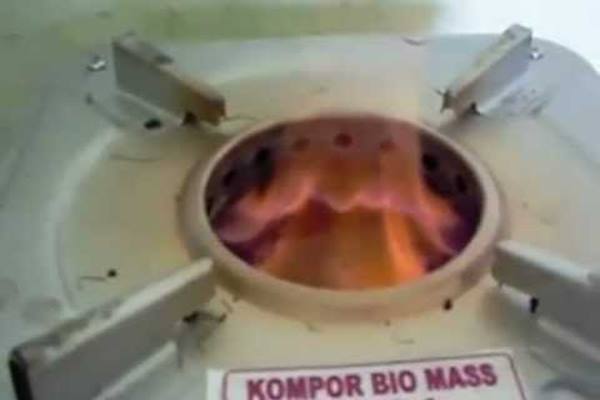
entrepreneur.bisnis.com - Theresia Rukiatun (45), the resident of Pagerjuang, Sleman, Yogyakarta once was upset because of LPG’s scarcity in 2013. As one of the dairy milk processor which depends on gas furnace, gas is her a vital fuel in her milk production.
As LPG scarcity was long-winding, she decided to switch to biogas. She was inspired by her neighbour. A dairy farmer who has adopted the use of biogas earlier. Immediately, she selected biogas to fuel her furnaces and her daily needs.
Rukiatun was willingly paid Rp 12.8 millions for biogas reactor installation costs. The installation was adjusted in accordance with the amount of gas required. She relied on various types of manures readily available as raw materials for biogas production. Ever since that day. Rukiatun did not complain anymore on gas scarcity.
“This year will mark my third year of using biogas. The benefit is obvious as well as safe. In addition to enable me to cut my expenses, I am thinking hard to generate additional revenues from the biogas production,” she said to Bisnis.com, Wednesday (9/14/2016).
Rukiatun is really happy. Her decision to adopt domestic biogas as a result of campaigns launched by the Dutch funding agency, Hivos and Yayasan Rumah Energi has transformed the pattern of her monthly financial expenditure patterns. Additionally, she was pleased to be a part of emission reduction and energy saving programme.
It is beyond the money saving feature that she has been enjoying so far. It turns out that, bio-slurry, the waste product of biogas is an excellent source of organic fertiliser. In fact, bio-slurry may be turned into an additional stream of income. “I would say that bio-slurry is an extra bonus,” she said.
Bio-slurry or biogas waste product, she said, may be produced up to 12 kilograms per day depending on the usage. Initially it comes in a liquid form. However, Rukiatun further processed the bio-slurry into a dried form by putting it into plastic bags or sacks leaving it to completely dry in a dedicated place.
Rukiatun is fully aware that bio-slurry may be a source of alternative fertiliser for farmers in her area. She started to collect the data of domestic biogas users in her area to jointly learn about the economic opportunities generated by bio-slurry.
“Throughout these times, I have been using it for my personal needs to fertilise crops around my house. However, there are biogas users who have sold a total weight of 1 ton of bio-slurry to farmer’s groups,” she said.
Meidi Syaflan, a researcher in Yogyakarta Agriculture Institute who happens to focus on bio-slurry research said that there are lacks of attention by both the government and the community on the benefit of bio-slurry. Most of them still focus on the benefit of biogas. They have overlooked the benefit of biogas and simply dispose the waste product.
According to him, knowledge on the bio-slurry potential or biogas waste product may support the community economy.
“This is espceially true for farmers who have been using anorganic fertiliser throughout these times,” he said to Bisnis.com during the bio-slurry seminar break in Bogor, Wednesday (9/14).
Data acquired through Hivos (Humanist Institute for Co-operation with Developing Countries) indicate, that bio-slurry is the end product of organic waste derived by cattle manure and organic waste through fermentation process.
Bio-slurry is deemed suitable for agriculture and pond fertilisers as well as fish and duck feeds. Composition of bio-slurry includes among other nitrogen, phosphorus, potassium, calcium, magnesium, sulphur, and micro nutrients such as magnesium and so forth.
Additionally, bio-slurry may fertilise the soil thus higher crop productivity level may be achieved. Today, extracting the Hivos data, there have been more than 15,000 farmers who have adopted biogas as clean energy for cooking and lighting purposes through domestic biogas (BIRU) programme.
Meidi explains that technological discovery beneficial for the community especially for farmers, such as bio-slurry, deserves serious attention from the government. Because, he continued, he feels that the government tends to disregard bio-slurry development.
“We want the government to facilitate the bio-slurry development. This is the civic programme which we hope may be properly managed. Embrace the community with this system so that they may be aware on the benefits of this discovery,” he said.
Today, the area with the highest bio-slurry adopter includes Central Java, Yogyakarta, and West Nusa Tenggara. All those three areas according to agricutural survey conducted on 2013 have the greatest population of dairy farmers in Indonesia. Therefore, cattle manures as raw materials for biogas productions to derive bio-slurry are plentiful in those areas.
He further said in addition to bio-slurry as the source of farmers’ community revenue, it is anticipated that the agricultural quality in Indonesia will steadily increase aong with the use of organic fertilisers derived from the bio-slurry.
Therefore, he continued, the government and anorganic fertiliser industry shall not be too worried with the organic fertiliser derived by the bio-slurry. “It is very likely that lack of focus by the government on this programme, is due to the potential conflict of interest with the relevant industry,” he said.
Muhammad Firdaus, a Professor in the Agricultural Department of Bogor Agricultural University said that the government’s policy today has improved and alllocate budget for organic fertilisers distribution to farmers.
He supported a follow-up programme with respect to the utilisation of agricultural technology by intensifying the use of organic fertilisers as well as bio-slurry.
Firdaus dismissed the perception that the use of organic fertilisers both manually prepared or derived from the biogas production will jeopardise the anorganic fertiliser industry. Because, he said, the use of those two types of fertilisers have their own unique purposes.
“As in some cases of the use organic fertilisers may not substitute the anorganic fertilisers. Phosphorus deficieny in a soil composition may not be replaced by the use of organic fertilisers. Therefore it is not true, that anorganic fertiliser industry will lose its market. However, it may experience a decline in its market penetration,” he said.
(Source: http://entrepreneur.bisnis.com/read/20160915/263/583979/javascript)


